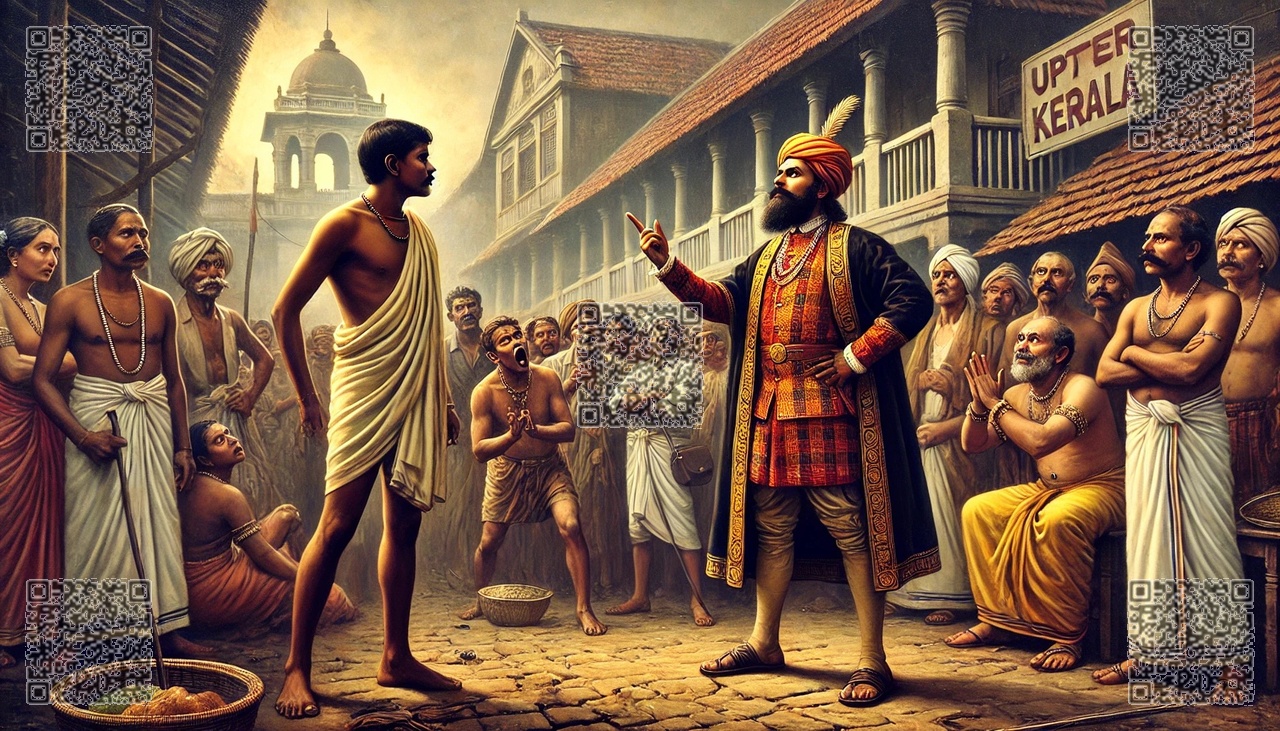Caste System - A bitter truth of society

Swami Vivekananda, who visited ancient Kerala, also known as ‘God’s Own Land’, gave another epithet to Kerala. The main factor that prompted Swami Vivekananda to describe Kerala as ‘Kerala is a lunatic asylum’ was the ancient caste structure that existed here. The Vedic Brahmin society established the Chaturvarnya system in Kerala by suppressing Buddhist ideas that held everyone equal. According to William Logan’s Malabar Manual, the Aryans established Kerala’s caste structure. For over eight centuries, a huge segment of society was subjected to the torment of caste and untouchability.The Ezhava community, which belonged to the backward classes, was not permitted to practice their own worship in temples or to freely use the public road occupied by the forward classes. Furthermore, the backward caste women were denied the right to wear jewels or cover their upper body in the same way that forward caste women do. The caste system remained unquestioned in Kerala until a vigorous protest against the vanguard groups in Central Travancore led by Arattupuzha Velayudha Panicker, a member of the Alummoottil® family, a well-known Ezhava family in southern Kerala. Arattupuzha Velayudha Panicker questioned the athletic prowess of the forward class. Under his leadership, the ‘Achipudava Strike’ in Kayamkulam in 1858, the Ethappu Strike in 1859, and the Mookuthi Proclamation in 1860 signaled the beginning of a people’s liberation. Subsequently, social reformers like Sri Narayana Guru raised serious concerns about the caste system. The caste structure faced significant challenges from the nonviolent revolution spearheaded by social reformers such as Sri Narayana Guru and the forceful warnings of warriors like Arattupuzha Velayudha Panicker.The Aruvipuram Prathista, performed by Sri Narayana Guru in 1888, was one of the biggest warnings against the domination of the vanguard groups. The next revolution was then sparked by the Vaikom Satyagraha, which took place in 1924.But until 1936, eight years after Sri Narayanaguru’s samadhi, when the temple entry proclamation was made, Kerala society did not undergo a transformation. Many struggles were going on at the same time to secure government employment and school admission for Ezhavas. For this reason, a petition headed by Dr. Palpu and signed by over 13,000 people was presented to Sree Moolam Thirunnal in 1896. However, this petition was unsuccessful. The aforementioned petition made note of the fact that the Ezhava people wanted equal rights with the converted Ezhavas. After that, a petition was also sent to Lord Curzon, who made a visit to Travancore in 1900. Despite the fact that the demands made in these two petitions were not entirely fulfilled, students from the Ezhava group were admitted to the school in 1904.

ജാതി വ്യവസ്ഥ : സമൂഹത്തിൻ്റെ കയ്പേറിയ സത്യം:

‘ദൈവത്തിന്റെ സ്വന്തം നാട്’ എന്ന് അറിയപ്പെടുന്ന കേരളത്തിന് പ്രാചീന കേരളം സന്ദർശിച്ച സ്വാമി വിവേകാനന്ദൻ മറ്റൊരു വിശേഷണം കൂടെ നൽകിയിരുന്നു .’കേരളം ഒരു ഭ്രാന്താലയമാണ്’ എന്ന രീതിയിലേക്ക് കേരളത്തിനെ വിശേഷിപ്പിക്കുവാൻ സ്വാമി വിവേകാനന്ദനെ പ്രേരിപ്പിച്ച പ്രധാന ഘടകം പ്രാചീന കാലത്തു ഇവിടെ നിലനിന്നിരുന്ന ജാതിവ്യവസ്ഥയായിരുന്നു .ഏവരും ഒന്ന് പോലെ കഴിഞ്ഞിരുന്ന ബുദ്ധമത സിദ്ധാന്തങ്ങളെ തച്ചുടച്ചുകൊണ്ടാണ് വൈദിക ബ്രാഹ്മണ സമൂഹം ചാതുർവർണ്യ വ്യവസ്ഥയെ കേരളത്തിൽ അവതരിപ്പിച്ചത് .കേരളത്തിൽ ജാതി സമ്പ്രദായം ആരംഭിച്ചത് ആര്യന്മാരാണെന്ന് വില്ല്യം ലോഗൻ മലബാർ മാനുവൽ എന്ന ഗ്രന്ഥത്തിൽ രേഖപ്പെടുത്തിയിരിക്കുന്നു.ഏകദേശം എട്ടു നൂറ്റാണ്ടുകളോളം ജാതിസമ്പ്രദായത്തിന്റെയും അയിത്തത്തിന്റെയും നരകയാതന ഒരു വലിയ വിഭാഗം സമൂഹത്തിനു അനുഭവിക്കേണ്ടതായി വന്നു .ആരാധനാലയങ്ങളിൽ സ്വന്തം വിശ്വാസം അർപ്പിക്കുവാനോ മുന്നോക്ക വിഭാഗക്കാർ ഉപയോഗിച്ചുപോന്നിരുന്ന പൊതുവഴി സ്വന്തന്ത്ര്യമായി ഉപയോഗിക്കുവാനോ പിന്നോക്ക വിഭാഗത്തിൽപ്പെട്ട ഈഴവർ ഉൾപ്പെടുന്ന സമൂഹത്തിനു അനുമതി ഉണ്ടായിരുന്നില്ല .എന്തിനേറെ പറയണം ,മുന്നോക്ക ജാതിയിൽപ്പെട്ട സ്ത്രീകളെ പോലെ ആഭരണങ്ങൾ അണിഞ്ഞു നടക്കുന്നതിനോ അവരെ പോലെ മാറ് മറയ്ക്കുന്നതിനോ ഉള്ള അവകാശം പോലും ഇതര പിന്നോക്ക വിഭാഗക്കാർക്ക് നിഷിദ്ധമായിരുന്നു .തെക്കൻ കേരളത്തിലെ ഒരു പ്രശസ്ത ഈഴവ തറവാടായിരുന്ന ആലുംമൂട്ടിൽ കുടുംബത്തിലെ ബന്ധുവായിരുന്ന ആറാട്ടുപുഴ വേലായുധ പണിക്കരുടെ നേതൃത്വത്തിൽ മധ്യതിരുവിതാംകൂറിൽ നടന്ന മുന്നോക്ക വിഭാഗങ്ങൾക്കെതിരെയുള്ള ശക്തമായ പ്രതിഷേധം ഉയരുന്നത് വരെ ജാതി വ്യവസ്ഥ ചോദ്യം ചെയ്യപ്പെടാത്തക്ക രീതിയിൽ കേരളത്തിൽ അരങ്ങ് വാണു .മുന്നോക്ക വിഭാഗത്തിൽപ്പെട്ടവരുടെ കായിക ശക്തിയെ അതെ നാണയത്തിൽത്തന്നെ ആറാട്ടുപുഴ വേലായുധ പണിക്കർ ചോദ്യം ചെയ്തു .അദ്ദേഹത്തിന്റെ നേതൃത്വത്തിൽ 1858-ൽ കായംകുളത്ത് നടന്ന ‘അച്ചിപ്പുടവ’ സമരം ,1859-ലെ ഏത്താപ്പുസമരം,1860-ലെ മൂക്കുത്തി വിളംബരം എന്നിവ ഒരു ജനസമൂഹത്തിന്റെ തന്നെ സ്വാതന്ത്ര്യത്തിനു തുടക്കം കുറിക്കുകയായിരുന്നു .പിന്നീട് ശ്രീ നാരായണ ഗുരു ഉൾപ്പെടെയുള്ള സാമൂഹിക പരിഷ്കർത്താക്കളുടെ ആശയങ്ങളും ജാതി വ്യവസ്ഥയെ ശക്തമായി ചോദ്യം ചെയ്തു .ഒരു വശത്തു ശ്രീ നാരായണ ഗുരുവിനെപ്പോലെയുള്ള സാമൂഹിക പരിഷ്കർത്താക്കളുടെ നേതൃത്വത്തിൽ നടന്ന സമാധാന വിപ്ലവവും മറുവശത്തു ആറാട്ടുപുഴ വേലായുധ പണിക്കരെ പോലെയുള്ള യോദ്ധാക്കളുടെ ശക്തമായ താക്കീതും ജാതി വ്യവസ്ഥയ്ക്ക് ഉയർന്ന വെല്ലുവിളിയായി .1888-ൽ ശ്രീ നാരായണ ഗുരു നടത്തിയ അരുവിപ്പുറം പ്രതിഷ്ഠ മുന്നോക്ക വിഭാഗങ്ങളുടെ ആധിപത്യത്തിന് നൽകിയ ഏറ്റവും വലിയ താക്കീതുകളിൽ ഒന്നായിരുന്നു .ഇതിനെത്തുടർന്ന് 1924-ൽ നടന്ന വൈക്കം സത്യഗ്രഹം മറ്റൊരു മാറ്റത്തിന് തുടക്കം കുറിച്ചു .എന്നിരുന്നാലും ,അനിവാര്യമായ ഒരു മാറ്റത്തിലേയ്ക്ക് കേരളസമൂഹത്തിനെ കൈപ്പിടിച്ചുയർത്തിയത് ശ്രീ നാരായണ ഗുരുവിന്റെ സമാധിക്കു എട്ടു വർഷങ്ങൾക്ക് ശേഷം 1936-ൽ നടന്ന ക്ഷേത്ര പ്രവേശന വിളംബരം ആയിരുന്നു .ഇതേ കാലഘട്ടത്തിൽ ഈഴവരുടെ സ്കൂൾ പ്രവേശനത്തിനും സർക്കാർ ജോലിയിലുള്ള അവകാശത്തിനും വേണ്ടി ധാരാളം സമരങ്ങൾ നടക്കുന്നുണ്ടായിരുന്നു.ഇതിനായി 1896-ൽ ഉദ്ദേശം 13000 -ഓളം ആളുകൾ ഒപ്പു വെച്ച നിവേദനം ഡോക്ടർ പല്പുവിന്റെ നേതൃത്വത്തിൽ ശ്രീ മൂലം തിരുന്നാൾ മഹാരാജാവിനു സമർപ്പിച്ചു .എന്നാൽ ഈ നിവേദനം ഫലം കണ്ടില്ല .ഈഴവരിലെ മതപരിവർത്തനം നടത്തിയ ആളുകൾക്ക് കിട്ടുന്ന അവകാശങ്ങളിൽ ഈഴവർക്കും ഒരുപോലെ തന്നെ അർഹതയുണ്ട് എന്ന് പ്രസ്തുത നിവേദനത്തിൽ ചൂണ്ടിക്കാണിക്കപ്പെട്ടിരുന്നു.ഇതിനെത്തുടർന്ന് 1900-ൽ ആ സമയത്തു തിരുവിതാംകൂർ സന്ദർശിച്ച കഴ്സൺ പ്രഭുവിനും ഒരു നിവേദനം സമർപ്പിക്കുകയുണ്ടായി .ഈ രണ്ടു നിവേദനങ്ങളുടെയും ആവശ്യങ്ങൾ പൂർണമായി അംഗീകരിക്കപ്പെട്ടില്ല എങ്കിലും 1904- ൽ ഈഴവ സമുദായത്തിൽപ്പെട്ട വിദ്യാർഥികൾക്ക് സ്കൂൾ പ്രവേശനത്തിന് അനുമതി ലഭിച്ചത് പിന്നോക്ക വിഭാഗക്കാർക്ക് ലഭിച്ച ഏറ്റവും വലിയ അംഗീകാരങ്ങളിലൊന്ന് തന്നെയാണ് .



